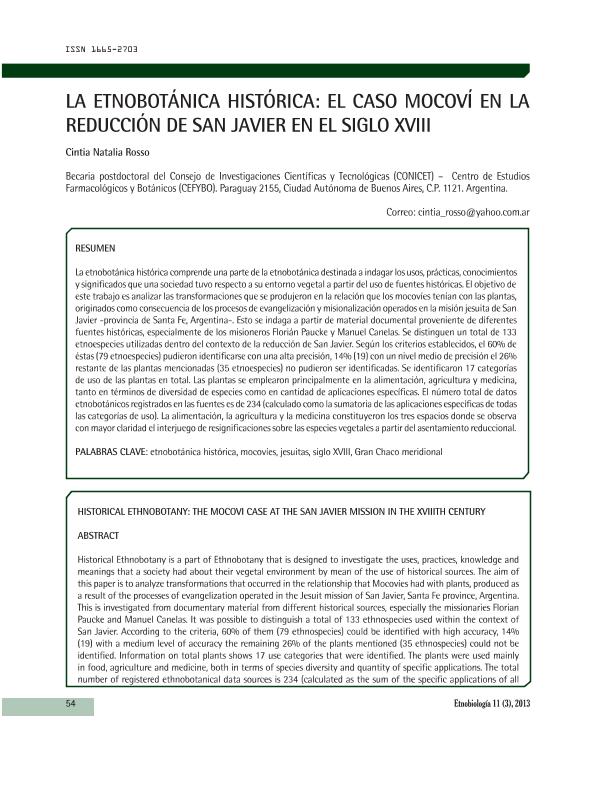Artículo
La etnobotánica histórica comprende una parte de la etnobotánica destinada a indagar los usos, prácticas, conocimientos y significados que una sociedad tuvo respecto a su entorno vegetal a partir del uso de fuentes históricas. El objetivo de este trabajo es analizar las transformaciones que se produjeron en la relación que los mocovíes tenían con las plantas, originados como consecuencia de los procesos de evangelización y misionalización operados en la misión jesuita de San Javier -provincia de Santa Fe, Argentina-. Esto se indaga a partir de material documental proveniente de diferentes fuentes históricas, especialmente de los misioneros Florián Paucke y Manuel Canelas. Se distinguen un total de 133 etnoespecies utilizadas dentro del contexto de la reducción de San Javier. Según los criterios establecidos, el 60% de éstas (79 etnoespecies) pudieron identificarse con una alta precisión, 14% (19) con un nivel medio de precisión el 26% restante de las plantas mencionadas (35 etnoespecies) no pudieron ser identificadas. Se identificaron 17 categorías de uso de las plantas en total. Las plantas se emplearon principalmente en la alimentación, agricultura y medicina, tanto en términos de diversidad de especies como en cantidad de aplicaciones específicas. El número total de datos etnobotánicos registrados en las fuentes es de 234 (calculado como la sumatoria de las aplicaciones específicas de todas las categorías de uso). La alimentación, la agricultura y la medicina constituyeron los tres espacios donde se observa con mayor claridad el interjuego de resignificaciones sobre las especies vegetales a partir del asentamiento reduccional. Historical Ethnobotany is a part of Ethnobotany that is designed to investigate the uses, practices, knowledge and meanings that a society had about their vegetal environment by mean of the use of historical sources. The aim of this paper is to analyze transformations that occurred in the relationship that Mocovíes had with plants, produced as a result of the processes of evangelization operated in the Jesuit mission of San Javier, Santa Fe province, Argentina. This is investigated from documentary material from different historical sources, especially the missionaries Florian Paucke and Manuel Canelas. It was possible to distinguish a total of 133 ethnospecies used within the context of San Javier. According to the criteria, 60% of them (79 ethnospecies) could be identified with high accuracy, 14% (19) with a medium level of accuracy the remaining 26% of the plants mentioned (35 ethnospecies) could not be identified. Information on total plants shows 17 use categories that were identified. The plants were used mainly in food, agriculture and medicine, both in terms of species diversity and quantity of specific applications. The total number of registered ethnobotanical data sources is 234 (calculated as the sum of the specific applications of all categories of use). Food, agriculture and medicine were the three areas where there is more clarity on the interplay of plant species resignified after the settlement missioner.
La etnobotánica histórica: el caso mocoví en la reducción de San Javier en el siglo XVIII
Título:
Historical ethnobotany: the mocovi case at the san javier mission in the XVIIIth century
Fecha de publicación:
12/2013
Editorial:
ASociación Etnobiológica Mexicana
Revista:
Revista Etnobiología
ISSN:
1665-2703
Idioma:
Español
Tipo de recurso:
Artículo publicado
Clasificación temática:
Resumen
Palabras clave:
Etnobotanica Historica
,
Mocovies
,
Jesuitas
,
Siglo Xviii
Archivos asociados
Licencia
Identificadores
Colecciones
Articulos(CEFYBO)
Articulos de CENTRO DE ESTUDIOS FARMACOLOGICOS Y BOTANICOS
Articulos de CENTRO DE ESTUDIOS FARMACOLOGICOS Y BOTANICOS
Citación
Rosso, Cintia Natalia; La etnobotánica histórica: el caso mocoví en la reducción de San Javier en el siglo XVIII; ASociación Etnobiológica Mexicana; Revista Etnobiología; 11; 3; 12-2013; 54-65
Compartir




